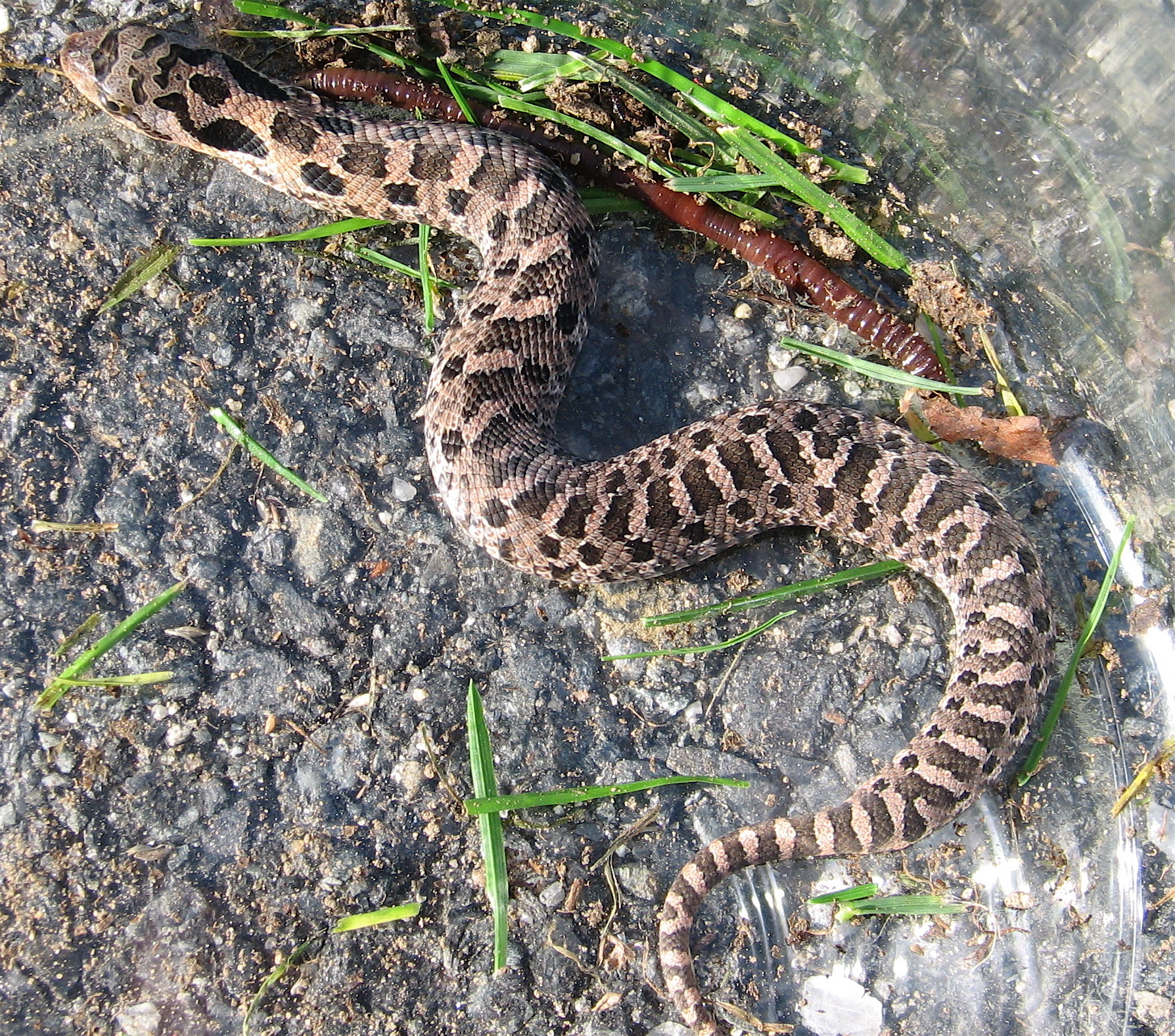Heterodon platirhinos
Eastern Hog-nosed Snake

Photo taken by Kelly Price.
You can easily see how thick the body is here.

Photo taken by Kiley Briggs.
Close-up of the head.

Photo taken by Patrick Coin.
Darker morphs of the Hognosed snake can be found in some areas. See also http://en.wikipedia.org /wiki/ Heterodon_ platirhinos

Photo taken by Kiley Briggs.
Close-up of the head, showing the snout from underneath.
JPlotkin.jpg)
Photo taken by J. Plotkin.
The distinctly colored underside of the tail.

Photo taken by Ken Barnett.
Three adults.
More images from google
Identification
The Eastern Hog-nosed Snake is a relatively short, fat snake. It is thick-bodied in proportion to its overall length. It ranges from 20-33 inches in length as an adult.
The hog-nosed snake gets its name from the upturned snout that is composed of a sharp-edged, three-sided scale. This is also one its best field marks.
The body color is highly variable. Lighter-colored snakes could be orange to brown with dark brown or black irregular blotches similar to a young Northern Watersnake or perhaps a Timber Rattlesnake. Dark snakes could be almost entirely olive-green or black on the back.
The underside of the chin is snow white. The belly is a cream to tawny tan color. The underside of the tail is pink. The scales of this species are keeled giving the snake a slightly rough feel. When threatened, the snake may flatten its head and anterior ribs and give the appearance of a cobra. Another defense mechanism used by the snake is feigning death. It does this by flipping onto its back with its mouth open, its tongue hanging out, and blood leaking from membranes within its mouth.
Range/Habitat
Dry areas with sandy soils are the preferred habitat for the Eastern Hog-nosed Snake. It hunts for amphibians (primarily toads) along the edges of swamps, bogs, and marshes. This snake can be seen in meadows and grasses along rivers, beaches, and railroad tracks. It also can be found in open pine or deciduous forests.
Status
The Eastern Hog-nosed Snake is a hypothetical species in Vermont. This snake was first photographed in Vermont in 2009. The photographs are of two young snakes about 2 miles apart in the town of Vernon. There are a total of three reports of this snake in the last four years from Vermont. The reports have come from Vernon and Rockingham. Nearby reports from New York State have come from towns bordering Sandgate and Fair Haven, Vermont. Nearby reports from Massachusetts come from towns bordering Vernon. Although this is a good sign that there may be a breeding population in the state, there have been no confirmed records of adult snakes yet in Vermont. With a few photographed records of adult snakes, the Eastern Hog-nosed Snake can possibly be moved onto the confirmed species list of snakes in Vermont. Please report all sightings of this species in Vermont. Take photos if possible!
More Info
- Heterodon platirhinos at the Animal Diversity website
- Heterodon platirhinos at the CARCNET website
- Heterodon platirhinos at the HerpNet website
- Heterodon platirhinos at the New Hampshire Fish and Game website
- Heterodon platirhinos at the Snakes of Massachusetts website
Species summary written by Michael Iacchetta.
In the Media
Garofalo, Chris. 2009. Vernon Family Finds Rare Snake in Vermont. Brattleboro Reformer (October 12, 2009). Available as text-only PDF printed from Reformer.com site (accessed October 16, 2009).
Mitchell, Tom. 2009. Rare Snake Discovered in Vernon. Rutland Herald (October 12, 2009). Available as text-only PDF printed from Rutland Herald site (accessed October 16, 2009).
